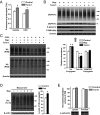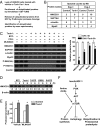mTOR inhibition activates overall protein degradation by the ubiquitin proteasome system as well as by autophagy
- PMID: 26669439
- PMCID: PMC4703015
- DOI: 10.1073/pnas.1521919112
mTOR inhibition activates overall protein degradation by the ubiquitin proteasome system as well as by autophagy
Abstract
Growth factors and nutrients enhance protein synthesis and suppress overall protein degradation by activating the protein kinase mammalian target of rapamycin (mTOR). Conversely, nutrient or serum deprivation inhibits mTOR and stimulates protein breakdown by inducing autophagy, which provides the starved cells with amino acids for protein synthesis and energy production. However, it is unclear whether proteolysis by the ubiquitin proteasome system (UPS), which catalyzes most protein degradation in mammalian cells, also increases when mTOR activity decreases. Here we show that inhibiting mTOR with rapamycin or Torin1 rapidly increases the degradation of long-lived cell proteins, but not short-lived ones, by stimulating proteolysis by proteasomes, in addition to autophagy. This enhanced proteasomal degradation required protein ubiquitination, and within 30 min after mTOR inhibition, the cellular content of K48-linked ubiquitinated proteins increased without any change in proteasome content or activity. This rapid increase in UPS-mediated proteolysis continued for many hours and resulted primarily from inhibition of mTORC1 (not mTORC2), but did not require new protein synthesis or key mTOR targets: S6Ks, 4E-BPs, or Ulks. These findings do not support the recent report that mTORC1 inhibition reduces proteolysis by suppressing proteasome expression [Zhang Y, et al. (2014) Nature 513(7518):440-443]. Several growth-related proteins were identified that were ubiquitinated and degraded more rapidly after mTOR inhibition, including HMG-CoA synthase, whose enhanced degradation probably limits cholesterol biosynthesis upon insulin deficiency. Thus, mTOR inhibition coordinately activates the UPS and autophagy, which provide essential amino acids and, together with the enhanced ubiquitination of anabolic proteins, help slow growth.
Keywords: autophagy; mTOR; proteasome; ubiquitination.
Conflict of interest statement
The authors declare no conflict of interest.
Figures




References
-
- Goldberg AL, St John AC. Intracellular protein degradation in mammalian and bacterial cells: Part 2. Annu Rev Biochem. 1976;45:747–803. - PubMed
-
- Ma XM, Blenis J. Molecular mechanisms of mTOR-mediated translational control. Nat Rev Mol Cell Biol. 2009;10(5):307–318. - PubMed
-
- Shimobayashi M, Hall MN. Making new contacts: The mTOR network in metabolism and signalling crosstalk. Nat Rev Mol Cell Biol. 2014;15(3):155–162. - PubMed
Publication types
MeSH terms
Substances
Grants and funding
LinkOut - more resources
Full Text Sources
Other Literature Sources
Miscellaneous

